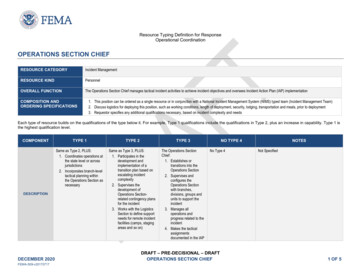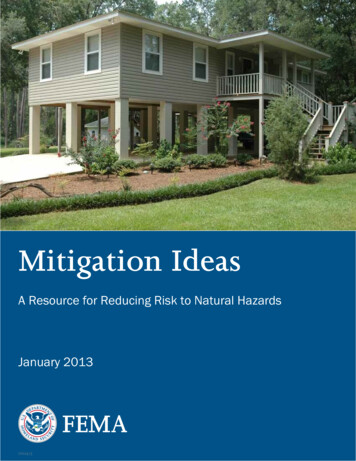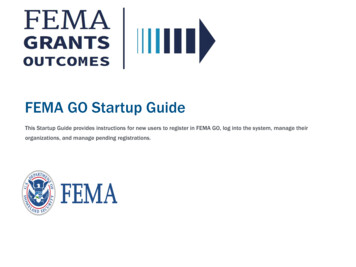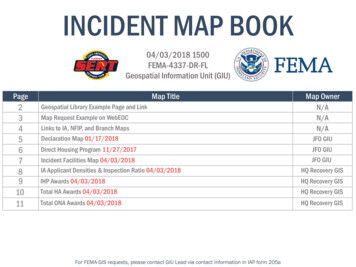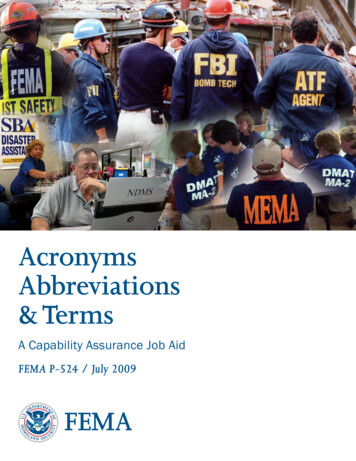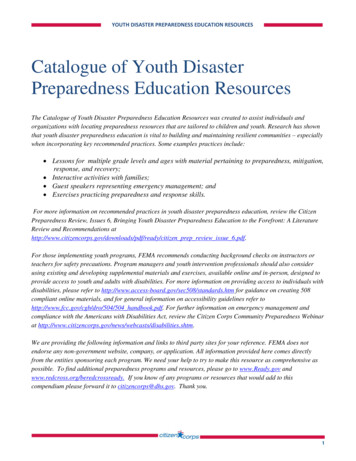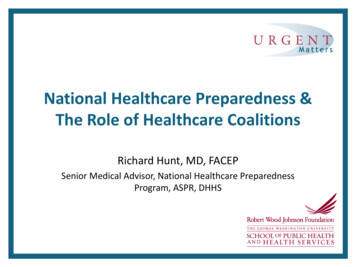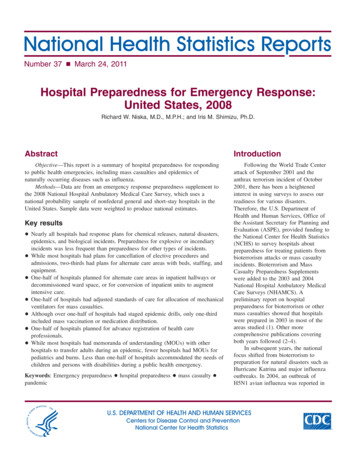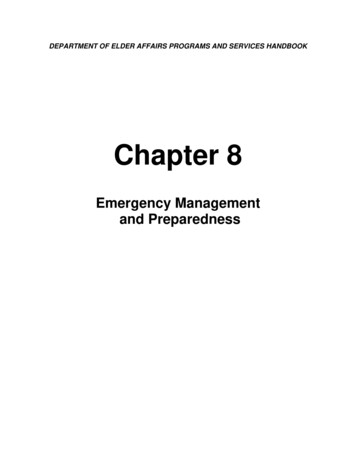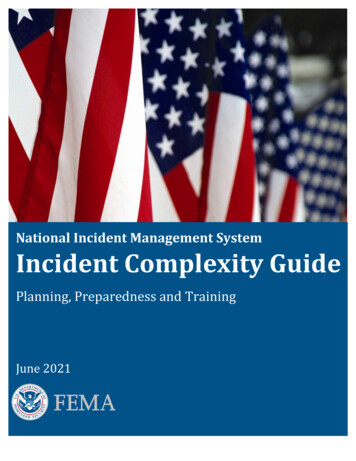
Transcription
National Incident Management SystemIncident Complexity GuidePlanning, Preparedness and TrainingJune 2021
NIMS Incident Complexity GuideThis page intentionally left blank
NIMS Incident Complexity GuideTable of Contents1.Introduction . 12.Overview . 22.1.Purpose . 22.1.1.2.2.Supporting NIMS and National Preparedness . 2Incident Complexity Levels . 32.2.1.Factors in Identifying Incident Complexity LEVELS . 32.2.2.Characteristics of Incident Complexity LEVELS . 4Incident Effect Indicators . 4Incident Management Indicators . 43.Instructions. 53.1.4.How to Select Incident Complexity Level . 5Incident Complexity Level Table . 6Type 5 . 6Type 4 . 7Type 3 . 8Type 2 . 10Type 1 . 125.Incident Effect Indicators Summary Table . 14Abbreviations . 15Glossary . 16Reference Resources. 21National Incident Management System (NIMS) . 21National Qualification System (NQS). 21Resource Typing Library Tool (RTLT) . 21Incident Command System (ICS) Resource Center . 21NIMS Training Program . 21NIMS Guideline for Mutual Aid . 22Integrated Preparedness Planning. 22i
NIMS Incident Complexity Guide1.IntroductionThe Incident Complexity Guide: Planning, Preparedness and Training supports the National IncidentManagement System (NIMS) doctrine by establishing guidance to support the incident managementand emergency management community. This guide promotes a common understanding within thewhole community by using a consistent method to describe incident complexity principles. It alsoestablishes a framework for determining incident complexity level to inform emergency planning,preparedness and training and to improve operational readiness to respond to real events andincidents.The intended audience for this Guide is any Authority Having Jurisdiction (AHJ). This audienceincludes agencies and organizations at all levels of government, as well as private sector entities andNongovernmental Organizations (NGO) with emergency management or incident supportresponsibilities. The guide provides a standard, repeatable and scalable method of classifying thecomplexity of an incident, event or exercise.Some organizations and jurisdictions have already developed guides and tools for identifyingincident complexity. In these cases, this guide supports existing resources to enhance the decisionmaking process across all hazards and jurisdictions and improve overall readiness. In addition tousing the guide for preparedness and training, AHJs may also use it to develop tools for supportingincident response.The Incident Complexity Guide is recognized nationally as part of a host of emergency managementguidance available from FEMA’s National Integration Center (NIC). Its concepts and instructions canenhance national preparedness and promote effective implementation of NIMS and the NationalPreparedness System.1
NIMS Incident Complexity Guide2.Overview2.1.PurposeThe Incident Complexity Guide is intended for use during planning, preparedness and training effortsto help organizations and jurisdictions improve their readiness to respond to real-world events. Thisguide can help those involved in preparedness make more fully informed planning, preparednessand training decisions. Jurisdictions can use this guide to develop learning materials to identify thecomplexity level of each operational incident, planned event, training or exercise (“incident” forshort).FEMA encourages AHJs to incorporate the concept of incident complexity levels into planning andtraining, whether by instruction, scenario exercises or building their own tools for implementation.This guide is not designed for use as a complexity analysis or decision-making tool during incidentresponse—though by supporting planning and training, this guide may help users as they respond toreal-world incidents in their jurisdictions. In addition, identifying complexity level also supportsincident/emergency management personnel as they manage additional, deployable resources.The term complexity level quantifies the level of difficulty or resistance an incident presents to thoseworking to successfully manage or mitigate it. As incidents may vary in their difficulty or resistance tomitigation or management, FEMA measures complexity level on a scale of 5 to 1, where Type 5 is theleast complex incident and the least resistant to management or mitigationIncident Complexity Guide: Planning, Preparedness and TrainingThe Incident Complexity Guide presents a national perspective that applies across multipledisciplines and incident types. This guide gives AHJs a shared understanding of how to defineincident complexity and a flexible approach for building on that understanding. The result willbe an improved approach to incident complexity that suits the whole community’s needs andresources.2.1.1.SUPPORTING NIMS AND NATIONAL PREPAREDNESSUsing a common approach and consistent method for determining complexity level will improve theeffectiveness and implementation of NIMS and the National Preparedness System. This approach toincident complexity promotes a common understanding among whole community partners—state,local, tribal and territorial (SLTT) and federal government agencies, NGOs, nonprofit organizationsand the private sector.This guide also promotes a better understanding of the complexity level assigned to the exercisesincident management personnel complete to improve or maintain their qualifications. For moreinformation on position qualifications, please refer to the following topics on the FEMA website:2
NIMS Incident Complexity Guide FEMA NIMS National Qualification System (NQS) – guidance and tools to help stakeholdersdevelop processes for qualifying, certifying and credentialing deployable emergency personnel FEMA NIMS Job Titles/Position Qualifications – documents defining the minimum criteriapersonnel serving in specific incident-related positions must attain before deploying to anincident2.2.Incident Complexity Levels2.2.1.FACTORS IN IDENTIFYING INCIDENT COMPLEXITY LEVELSIncident complexity reflects the combination of factors affecting how severe, widespread and difficultto control an incident is. Many factors determine complexity level, including the following: Geographic area involved Values at risk Level of threat to life and property Weather Political sensitivity Strategy and tactics Organizational complexity Agency policy Jurisdictional boundaries How routine or unusual the incident isIncident and emergency management personnel consider complexity level when making decisionsabout incident management training, staffing and safety. Various obscure factors or concurrentevents may complicate incidents—such as isolation of location, social factors, resource availabilityand long-lasting complications. Planning for potential incident escalation applies to complexity leveldue to potential adverse impacts or unknown variables. Being ready for potential adverse effects andthe length of time for resources arriving on scene are important factors in determining how torespond to an incident. The AHJ has the freedom to determine how such factors affect incidentcomplexity.3
NIMS Incident Complexity Guide2.2.2.CHARACTERISTICS OF INCIDENT COMPLEXITY LEVELSIncident/emergency management personnel can determine the complexity level (Types 5 through 1)by reviewing a standard set of observable characteristics that an incident displays or an exerciseencompasses. These characteristics fall into two categories:Incident Effect IndicatorsIncident Effect Indicators are observable characteristics that help leaders determine complexity levelbased on the impact an incident has. These characteristics vary in scale depending on an incident’scomplexity. FEMA defines Incident Effect Indicators as observable “damage, consequence ordisruption to the residents, population, infrastructure and government operations surrounding theincident or event.”Incident Management IndicatorsIncident Management Indicators assist incident and emergency personnel in managing andsupporting incidents of any complexity level by helping them complete the following under theIncident Command System (ICS): Understand and anticipate incident management conditions and determine appropriatemanagement structure Provide necessary and appropriate structures for response, management and coordination Align off-site resources and logistical support requirementsThe Incident Complexity Level Table below lists specific characteristics for each of these twocategories of indicators for all five complexity levels.4
NIMS Incident Complexity Guide3.Instructions3.1.How to Select Incident Complexity LevelTo select the appropriate complexity level, an AHJ can refer to the Incident Complexity Level Table onthe following pages and follow these steps:1. Review the Incident Effect Indicators for Type 5 (the least complex incident level). If the incidentdisplays all or most of these Incident Effect Indicators, move on to Type 4. But if the incidentdisplays only a few of the Type 5 Incident Effect Indicators, the incident likely aligns withcomplexity level Type 5.2. Review the Incident Effect Indicators for Type 4. If the incident displays all or most of theseIncident Effect Indicators, move on to Type 3. But if the incident displays only a few of the Type 4Incident Effect Indicators, the incident likely aligns with complexity level Type 4.3. Review the Incident Effect Indicators for Types 3, 2 and 1, if necessary. You will know you havefound the most likely complexity level when the incident displays all or most of the Incident EffectIndicators for the previous level but not for the current complexity level. That is, once you reachthe type at which the incident does not display all/most of the Incident Effect Indicators, you canassume you have found the right complexity level.4. Once you determine the complexity level, use the Incident Management Indicators to guide andinform a scalable response to the incident within ICS.oIn rapidly escalating incidents, the Incident Management Indicators often lag behind theIncident Effect Indicators.oIf the incident displays all or most of the Incident Effect Indicators at a particular complexitylevel but none or few of the Incident Management Indicators, you can assume that you havefound the correct complexity level but that the response has not yet scaled to address theneeds indicated under the Incident Management Indicators.5. Note the following:oIncidents differ in their rate and extent of escalation to more complex levels. It is theemergency management personnel’s responsibility to determine the new complexity level inthe instance of incident escalation.oMost indicators are common to all incidents, but some may be unique to a particularcomplexity level.5
NIMS Incident Complexity Guide4.Incident Complexity Level TableThe language in the Incident Complexity Level Table is intentionally flexible, allowing AHJs to applythis guide to their specific needs and situations. Due to differences in infrastructure, incidentmanagement capability, population density, available resources, and other factors, it is possible thatone jurisdiction may identify an incident at one level of complexity while another jurisdiction mayidentify it as a different level. This guide applies to all hazards and is available for the wholecommunity to use as appropriate.Type 5Incident Effect IndicatorsIncident Management Indicators Incident shows no resistance tostabilization or mitigation Incident Commander (IC) position isfilled, but Command and General Staffpositions are unnecessary to reduceworkload or span of control Resources typically meet incidentobjectives within one or two hours ofarriving on scene5 EOC activation is unnecessary Minimal effects to populationimmediately surrounding the incident Unified Command is not typicallynecessary Few or no evacuations necessary duringmitigation One or more resources are necessaryand receive direct supervision from theIC No adverse impact on criticalinfrastructure and key resources (CIKR) Elected/appointed governing officialsand stakeholder groups require minimalor no coordination, and may not neednotification Conditions or actions that caused theincident do not persist; as a result, thereis no probability of a cascading event orexacerbation of the current incident Resources may remain on scene forseveral hours, up to 24, but require littleor no logistical support Formal incident planning process is notnecessary Written Incident Action Plan (IAP) isunnecessary Limited aviation resources may benecessary and may use varying levels ofair supportExamples: Type 5 incidents, events and exercises can include a vehicle fire, a medicalresponse to an injured/sick person, a response to a suspicious package/ item, or avehicle pursuit. Planned events can include a 5K or 10K road race.6
NIMS Incident Complexity GuideType 4Incident Effect IndicatorsIncident Management Indicators Incident shows low resistance tostabilization or mitigation IC/Unified Command role is filled, butCommand and General Staff positionsare typically not necessary to reduceworkload or span of control Resources typically meet incidentobjectives within several hours ofarriving on scene Incident may extend from several hoursto 24 hours Limited effects to populationsurrounding incident Few or no evacuations necessary duringmitigation4 Incident threatens, damages, ordestroys a minimal number ofresidential, commercial or culturalproperties CIKR may suffer adverse impacts CIKR mitigation measures areuncomplicated and can be implementedwithin one operational period EOC activation may be necessary Resources receive direct supervisioneither from the IC/Unified Command orthrough an ICS leader position, such asa Task Force or Strike Team/ResourceTeam, to reduce span of control Division or Group Supervisor positionmay be filled for organizational or spanof control purposes Multiple kinds and types of resourcesmay be necessary Aviation resources may be necessaryand may use varying levels of airsupport Resources may remain on scene for 24hours or longer and may require limitedlogistical support Elected/appointed governing officialsand stakeholder groups require minimalor no coordination, but they may need to Formal incident planning process is notnecessarybe notified Written IAP is unnecessary, but leaders Conditions or actions that caused themay complete a documentedoriginal incident do not persist; as aoperational briefing for all incomingresult, there is low to no probability of aresourcescascading event or exacerbation of thecurrent incidentExamples: Type 4 incidents, events and exercises can include a barricaded suspect, ahazardous materials (HAZMAT) spill on a roadway or waterway, a detonation of a smallexplosive device, a large commercial fire or a localized flooding event affecting aneighborhood or subdivision. Planned events can include a march, protest, festival, fair,or parade.7
NIMS Incident Complexity GuideType 3Incident Effect IndicatorsIncident Management Indicators Incident shows moderate resistance tostabilization or mitigation IC/Unified Command role is filled Resources typically do not meet incidentobjectives within the first 24 hours ofresources arriving on scene Command Staff positions are filled toreduce workload or span of control Incident may extend from several daysto over one week Population within and immediatelysurrounding incident area may requireevacuation or shelter during mitigation Incident threatens, damages, ordestroys residential, commercial orcultural properties CIKR may suffer adverse impacts CIKR mitigation actions may extend intomultiple operational periods3 Elected/appointed governing officialsand stakeholder groups require somelevel of coordination Conditions or actions that caused theincident may persist; as a result, there ismedium probability of a cascading eventor exacerbation of the current incident EOC activation may be necessary At least one General Staff position isfilled to reduce workload or span ofcontrol Numerous resources receivesupervision indirectly through theOperations Section and its subordinatepositions Branch Director position(s) may be filledfor organizational purposes andoccasionally for span of control Division Supervisors, GroupSupervisors, Task Forces and StrikeTeams/Resource Teams are necessaryto reduce span of control ICS functional units may be necessaryto reduce workload Incident typically extends into multipleoperational periods Resources may need to remain onscene for over a week and will requirelogistical support Incident may require an incident baseto support resources Numerous kinds and types of resourcesmay be required Aviation operations may involve multipleaircraft Number of responders depends on thekind of incident but could add up toseveral hundred personnel Leaders initiate and follow formalincident planning process Written IAP may be necessary for eachoperational period8
NIMS Incident Complexity GuideType 3Incident Effect IndicatorsIncident Management IndicatorsExamples: Type 3 incidents, events and exercises can include a tornado that damages asmall section of a city, village or town; a railroad tank car HAZMAT leak requiringevacuation of a neighborhood or section of a community; a detonation of a largeexplosive device; an active shooter; a water main break; a Category 1 or 2 hurricane; or asmall aircraft crash in a populated area. Planned events can include a county fair or anauto racing event.9
NIMS Incident Complexity GuideType 2Incident Effect IndicatorsIncident Management Indicators Incident shows high resistance tostabilization or mitigation IC/Unified Command role is filled Resources typically do not meet incidentobjectives within the first several days All Command Staff positions are filled Incident may extend from several daysto two weeks Population within and surrounding thegeneral incident area is affected Affected population may requireevacuation, shelter or housing duringmitigation for several days to months2 EOC activation is likely necessary All General Staff positions are filled Large numbers of resources receivesupervision through the OperationsSection Branch Director position(s) may be filledfor organizational or span of controlpurposes Incident threatens damages, or destroysresidential, commercial, and culturalproperties Division Supervisors, Group Supervisors,Task Forces, Strike Teams andResource Teams are necessary toreduce span of control CIKR may suffer adverse impacts,including destruction Most ICS functional units are filled toreduce workload CIKR mitigation actions may extend intomultiple operational periods, requiringconsiderable coordination Incident extends into numerousoperational periods Elected/appointed governing officials,political organization and stakeholdergroups require a moderate level ofcoordination Incident has resulted in externalinfluences, has widespread impact andinvolves political and media sensitivitiesrequiring comprehensive management Conditions or actions that caused theoriginal incident may persist, so acascading event or exacerbation of thecurrent incident is highly probable Resources may need to remain onscene for several weeks and will requirecomplete logistical support, as well aspossible personnel replacement Incident requires an incident base andother ICS facilities for support Numerous kinds and types of resourcesmay be required Complex aviation operations involvingmultiple aircraft may be involved Size and scope of resource mobilizationnecessitates a formal demobilizationprocess Length of resource commitment maynecessitate a transfer of command fromone Incident Management Team (IMT)to a subsequent IMT Number of responders depends on thekind of incident but could add up to over1,000 personnel Leaders initiate and follow formalincident planning process Written IAP is necessary for eachoperational period10
NIMS Incident Complexity GuideType 2Incident Effect IndicatorsIncident Management Indicators Leaders may order and deploy out-ofstate resources such as through theEmergency Management AssistanceCompact (EMAC)Examples: Type 2 incidents, events and exercises can include a tornado that damages anentire section of a city, village or town; a railroad tank car HAZMAT leak requiring aseveral-days-long evacuation of an entire section of a city, village or town; a wildland firein an area with numerous residences, requiring evacuations and several days offirefighting; a multi-event explosive device attack; or a river flooding event affecting anentire section of a city, village or town, with continued precipitation anticipated. Plannedevents can include a VIP visit, a large demonstration, a strike or a large concert.11
NIMS Incident Complexity GuideType 1Incident Effect IndicatorsIncident Management Indicators Incident shows high resistance tostabilization or mitigation IC/Unified Command role is filled Incident objectives cannot be met withinnumerous operational periods Unified Command is complex due to thenumber of jurisdictions involved Incident extends from two weeks to overa month All Command Staff positions are filled;many include assistants Population within and surrounding theregion or state where the incidentoccurred is significantly affected All General Staff positions are filled;many include deputy positions Incident threatens, damages, ordestroys significant numbers ofresidential, commercial, and culturalproperties Incident damages or destroys numerousCIKRs CIKR mitigation extends into multipleoperational periods and requires longterm planning and extensivecoordination1 Evacuated or relocated populations mayrequire shelter or housing for severaldays to months Elected/appointed governing officials,political organizations and stakeholdergroups require a high level ofcoordination Incident has resulted in externalinfluences, has widespread impact andinvolves political and media sensitivitiesrequiring comprehensive management Conditions or actions that caused theoriginal incident still exist, so acascading event or exacerbation of thecurrent incident is highly probable EOC activation is necessary Many resources receive supervisionthrough an expanded OperationsSection Branch Director position(s) may be filledfor organizational or span of controlpurposes Division Supervisors, Group Supervisors,Task Forces, Strike Teams, andResource Teams are necessary toreduce span of control Most or all ICS functional units are filledto reduce workload Incident extends into many operationalperiods Resources will likely need to remain onscene for several weeks and will requirecomplete logistical support, as well aspossible personnel replacement Incident requires an incident base andnumerous other ICS facilities for support Numerous kinds and types of resourcesmay be required, including many thattrigger a formal demobilization process Federal assets and other nontraditionalorganizations – such as VoluntaryOrganizations Active in Disaster (VOAD)and NGOs – may be involved in theresponse, requiring close coordinationand support Complex aviation operations involvingnumerous aircraft may be involved Size and scope of resource mobilizationnecessitates a formal demobilizationprocess12
NIMS Incident Complexity Guide Length of resource commitment maynecessitate a transfer of command fromone IMT to a subsequent IMT Number of responders depends on thekind of incident but could add up to over1,000 personnel Leaders initiate and follow formalincident planning process Written IAP is necessary for eachoperational period Leaders may order and deploy out-ofstate resources, such as through EMACExamples: Type 1 incidents, events and exercises can include a tornado with damage ordestruction to an entire community; a Category 3, 4 or 5 hurricane; a pandemic; arailroad tank car explosion or multilevel explosive device destroying severalneighborhoods and damaging others; a large wind-driven wildland fire threatening anentire city, village or town, causing several evacuations and destroying many homes,businesses, and critical infrastructure assets; or a widespread river flooding event in acity, village, or town, with continued precipitation anticipated. Planned events can includea political convention, the Super Bowl, the World Series or a presidential visit.13
NIMS Incident Complexity Guide5.Incident Effect Indicators Summary TableThis table supports the Incident Effect Indicators listed in the above Incident Complexity Level Tables across all hazards and provides abasis for training to determine incident complexity. Users can identify indicators with ease of use in addition to the detail provided above.Incident Complexity Level: Incident Effect Indicators SummaryCIKR impact /mitigationmeasuresCoordinationrequired withelected/governingofficials andstakeholdergroupsDo conditionsor actionsthat causedoriginalincidentpersist?Probability ofcascadingevent orexacerbationof currentincidentNoneNoneMinimal or noneNoNoneFew or noneMinimalUncomplicatedwithin oneoperational periodMinimal or noneNoLow to noneModerateSeveraldays toover oneweekPossible; mayrequire shelterThreatens,damages, ordestroyspropertyAdverse; multipleoperational periodsSomePossiblyMediumSignificantSeveraldays totwoweeksPossible; mayrequireshelter/housing forseveral daysto monthsThreatens,damages, ordestroyspropertyDestructive;requirescoordination overmultiple operationalperiodsModerate,including politicalorganizationsPossiblyHighTwoweeks toover amonthMay requireshelter/housing forseveral daysto monthsSignificantlythreatens,damages, ordestroyspropertyHighly destructive;requires long-termplanning andextensivecoordination overmultiple operationalperiodsHigh, cetostabilizationor mitigationHow longdoes it takefor resourcesto meetincidentobjectives?Effects onpopulationimmediatelysurroundingthe yduringmitigationAdverseimpact onCIKR5None1-2 hoursMinimalMinimalFew or none4LowSeveral to 24hoursLimitedUp to 24hoursModerateAt least 24hours321HighHighSeveral daysNumerousoperationalperiodsSignificant14
NIMS Incident Complexity GuideAbbreviationsAHJAuthority Having JurisdictionCIKRcritical infrastructure and key resourcesEMACEmergency Management Assistance CompactFEMAFederal Emergency Management AgencyHAZMAThazardous materialsHSEEPHomeland Security Exercise and Evaluation ProgramIAPIncident Action PlanICIncident CommanderICPIncident Command PostICSIncident Command SystemIMTIncident Management TeamNICNational Integration CenterNIMSNational Incident Management SystemNGONongovernmental OrganizationNPGNational Preparedness GoalNQSNational Qualification SystemPSCPlanning Section ChiefPTBPosition Task BookRTLTResource Typing Library ToolSLTTstate, local, tribal and territorialSPRStakeholder Preparedness ReviewTHIRAThreat and Hazard Identification and Risk AssessmentVOADVoluntary Organizations Active in Disaster15
NIMS Incident Complexity GuideGlossaryagency: A government ele
the incident complexity guide is intended for use during planning, preparedness and training efforts to help organizations and jurisdictions improve their readiness to respond to real-world events. this guide can help those involved in preparedness make more fully informed planning, preparedness and training decisions. jurisdictions can use this
